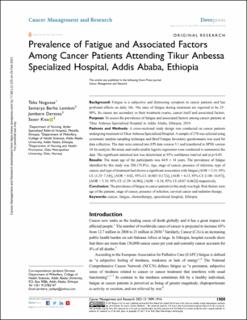| dc.contributor.author | Nugusse, Teka | |
| dc.contributor.author | Lemlem, Semarya Berhe | |
| dc.contributor.author | Deressa, Jembere | |
| dc.contributor.author | Kisa, Sezer | |
| dc.coverage.spatial | Ethiopia, Addis Ababa | en_US |
| dc.date.accessioned | 2021-06-17T11:52:58Z | |
| dc.date.available | 2021-06-17T11:52:58Z | |
| dc.date.created | 2021-02-24T22:57:36Z | |
| dc.date.issued | 2021-02-24 | |
| dc.identifier.citation | Cancer Management and Research. 2021, 13, (1909-1916). | en_US |
| dc.identifier.issn | 1179-1322 | |
| dc.identifier.uri | https://hdl.handle.net/11250/2759972 | |
| dc.description.abstract | Background: Fatigue is a subjective and distressing symptom in cancer patients and has profound effects on daily life. The rates of fatigue during treatment are reported to be 25– 90%. Its causes are secondary to their treatment course, cancer itself and associated factors.
Purpose: To assess the prevalence of fatigue and associated factors among cancer patients at Tikur Anbessa Specialized Hospital in Addis Ababa, Ethiopia, 2019.
Patients and Methods: A cross-sectional study design was conducted on cancer patients undergoing treatment in Tikur Anbessa Specialized Hospital. A sample of 278 was selected using systematic random sampling technique and Brief Fatigue Inventory questionnaire was used for data collection. The data were entered into EPI data version 3.1 and transferred to SPSS version 24 for analysis. Bivariate and multivariable logistic regression were conducted to summarize the data. The significant statistical test was determined at 95% confidence interval and at p< 0.05.
Results: The mean age of the participants was 44.9 ± 14 years. The prevalence of fatigue identified by this study was 208 (74.8%). Age, stage of cancer, presence of infection, type of cancer, and type of treatment had shown a significant association with fatigue [AOR = 3.15, 95% CI: (1.35– 7.34)], [AOR = 0.02, 95% CI: (0.003– 0.172)], [AOR = 4.15, 95% CI: (1.06– 16.07)], [AOR = 5.19, 95% CI: (1.59– 16.90)], [AOR = 0.18, 95% CI: (0.07– 0.462)] respectively.
Conclusion: The prevalence of fatigue in cancer patients in this study was high. Risk factors were age of the patients, stage of cancer, presence of infection, cervical cancer and radiation therapy. | en_US |
| dc.language.iso | eng | en_US |
| dc.publisher | Dove Medical Press | en_US |
| dc.relation.ispartofseries | Cancer Management and Research;volume 13 | |
| dc.rights | Navngivelse-Ikkekommersiell 4.0 Internasjonal | * |
| dc.rights.uri | http://creativecommons.org/licenses/by-nc/4.0/deed.no | * |
| dc.subject | Cancer | en_US |
| dc.subject | Fatigues | en_US |
| dc.subject | Chemotherapy | en_US |
| dc.subject | Specialized hospitals | en_US |
| dc.subject | Ethiopia | en_US |
| dc.title | Prevalence of Fatigue and Associated Factors Among Cancer Patients Attending Tikur Anbessa Specialized Hospital, Addis Ababa, Ethiopia | en_US |
| dc.type | Peer reviewed | en_US |
| dc.type | Journal article | en_US |
| dc.description.version | publishedVersion | en_US |
| dc.rights.holder | © 2021 Nugusse et al. | en_US |
| cristin.ispublished | true | |
| cristin.fulltext | original | |
| dc.identifier.doi | https://doi.org/10.2147/CMAR.S291298 | |
| dc.identifier.cristin | 1893456 | |
| dc.source.journal | Cancer Management and Research | en_US |
| dc.source.volume | 13 | en_US |
| dc.source.pagenumber | 1909-1916 | en_US |

